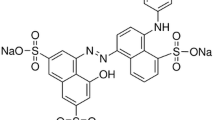Abstract
Removal of TCE by Biological Powdered Activated Carbon (BPAC), inoculated with Burkholderia vietnamiensis G4 and fed with toluene as the growth substrate, was investigated in fed-batch mode reactors, focusing on the regeneration of Powdered Activated Carbon (PAC). Cell-only and PAC-only reactors were operated in parallel for comparison. BPAC, once acclimated, removed toluene and TCE faster than cell-only or PAC-only reactors, leaving the lowest residuals in the liquid. This was amplified when the substrate dose was elevated. Toluene competitively adsorbed into the BPAC, resulting in TCE desorption, which accelerated bioregeneration of the TCE-sorbed BPAC. The regenerated BPAC exerted a similar adsorption capacity to PAC and a similar biodegradation capability to virgin BPAC under the experimental conditions. An acclimation of cells on TCE was necessary before its degradation, which indicated that TCE cometabolism may not be a fortuitous reaction. When a bioactive zone is constructed with BPAC, it is expected that TCE in the groundwater will be adsorbed to the BPAC; then, the adsorbed TCE will be desorbed and cometabolized upon pulse injections of toluene. A portion of left-over toluene will be stored in the BPAC and utilized for later TCE cometabolization.
Similar content being viewed by others
References
Aktas, O. and Cecen, F (2007). “Competitive adsorption and desorption of a bi-solute mixture: Effect of activated carbon type.” Adsorption, Vol. 13, No. 2, pp. 159–169.
Alvarez-Cohen, L., McCarty, P. L. (1991). “Effects of toxicity, aeration, and reductant supply on trichloroethylene transformation by a mixed methanotrophic culture.” Appl. Environ. Microbiol., Vol. 57, No. 1, pp. 228–235.
Baek, W. and Lee, J. Y. (2011). “Source apportionment of trichloroethylene in groundwater of the industrial complex in Wonju, Korea: A 15- year dispute and perspective.” Water and Environ. J., Vol. 25, No. 3, pp. 336–344.
Erlanson, B. C., Dvorak, B. I., Speitel, G. E., and Lawler, D. F. (1997). “Equilibrium model for biodegradation and adsorption of mixtures in GAC columns.” J. Environ. Eng., Vol. 123, No. 5, pp. 469–478.
Folsom, B. R., Chapman, P. J., and Pritchard, P. H. (1990). “Phenol and trichloroethylene degradation by Pseudomonas cepacia G4: Kinetics and interactions between substrates.” Appl. Environ. Microbiol., Vol. 56, No. 5, pp. 1279–1285.
Ivancev-Tumbas, I., Dalmacija, B., Tamas, Z., and Karlovic, E. (1998). “Reuse of biologically regenerated activated carbon for phenol removal.” Water Res., Vol. 32, No. 4, pp. 1085–1094.
Kilduff, J. E. and Wigton, A. (1999). “Sorption of TCE by humicpreloaded activated carbon: Incorporating size-exclusion and pore blockage phenomena in a competitive adsorption model.” Environ. Sci. Technol., Vol. 33, No. 2, pp. 250–256.
Luu, P. P., Yung, C. W., Sun, A. K., and Wood, T. K. (1995). “Monitoring trichloroethylene mineralization by Pseudomonas cepacia G4 PR1.” Appl. Microbiol. Biotech., Vol. 44, Nos. 1–2, pp. 259–264.
Marquez, M. C. and Costa, C. (1996). “Biomass concentration in pact process.” Water Res., Vol. 30, No. 9, pp. 2079–2085.
McCarty, P. L., Goltz, M. N., Hopkins, G. D., Dolan, M. E., Allan, J. P., Kawakami, B. T., and Carrothers, T. J. (1998). “Full scale evaluation of in situ cometabolic degradation of trichloroethylene in groundwater through toluene injection.” Environ. Sci. Technol., Vol. 32, No. 1, pp. 88–100.
McDade, J. M., McGuire, T. M., and Newell, C. J. (2005). “Analysis of DNAPL source-depletion costs at 36 field sites.” Rem.. J., Vol. 15, No. 2, pp. 9–18.
Michael, D., LaGrega PLB, and Jeffrey, C. (2001). Hazardous waste management, 2nd Ed., McGraw-Hill Higher Eduacation, United States.
Mu, D. Y. and Scow, K. M. (1994). “Effect of trichloroethylene (TCE) and toluene concentrations on TCE and toluene biodegradation and the polulation density of TCE and toluene degradation in soil.” Appl. Environ. Microbiol., Vol. 60, No. 7, pp. 2661–2665.
Nakano, Y., Hua, L. Q., Nishijima, W., Shoto, E., and Okada, M. (2000). “Biodegradation of trichloroethylene (TCE) adsorbed on Granular Activated Carbon (GAC).” Water Res., Vol. 34, No. 17, pp. 4139–4142.
Putz, A. R. H., Losh, D. E., and Speitel, G. E. (2005). “Removal of nonbiodegradable chemicals from mixtures during granular activated carbon bioregeneration.” J. Environ. Eng., Vol. 131, No. 2, pp. 196–205.
Voice, T. C., Pak, D., Zhao, X. D., Shi, J., and Hickey, R. F. (1992). “Biological activated carbon in fluidized bed reactors for the treatment of groundwater contaminated with volatile aromatic hydrocarbons.” Water Res., Vol. 26, No. 10, pp. 1389–1401.
Wu, W. M., Shi, J., and Hickey, R. F. (2008). “Long-term performance of co-metabolic degradation of trichloroethylene in a fluidized bed reactor fed with benzene, toluene and xylene.” J. Chemi. Technol. Biotechnol., Vol. 83, No. 4, pp. 513–523.
Author information
Authors and Affiliations
Corresponding author
Rights and permissions
About this article
Cite this article
Kwon, K., Bae, W., Oh, J. et al. Enhancing bioregeneration of TCE-sorbed Biological Powdered Activated Carbon by dosing toluene as primary substrate and competitive adsorbate. KSCE J Civ Eng 19, 550–557 (2015). https://doi.org/10.1007/s12205-013-1372-z
Received:
Revised:
Accepted:
Published:
Issue Date:
DOI: https://doi.org/10.1007/s12205-013-1372-z




